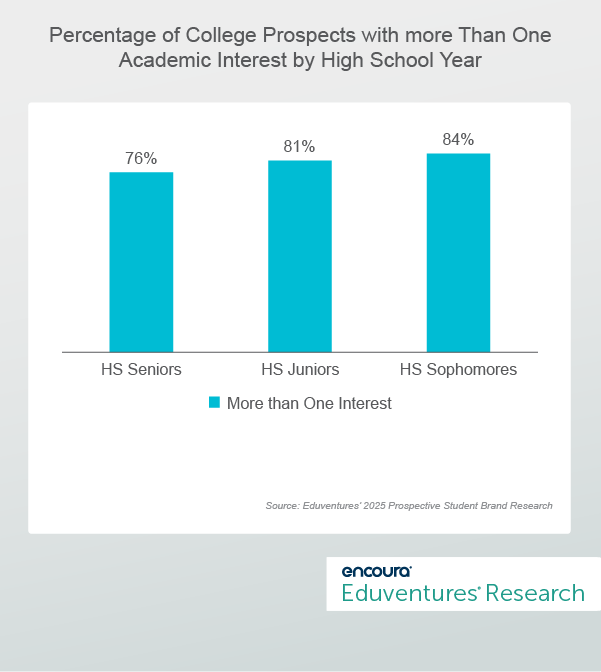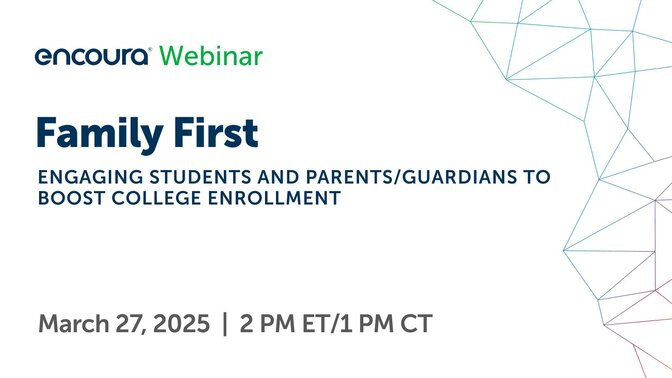Knowing a prospective student’s academic interest has become critical to connecting with them in meaningful and compelling ways during college search. Increasingly, college selection among high school students is driven by career preparation: 87% of college-bound students base their major interests on career outcomes, boosting the popularity of fields like health professions, engineering, biology, business, and computer science.
Despite their initial confidence, however, many of these students eventually change their minds either before or after they make a college choice. What implications does this have for your recruiting and retention efforts?
College-bound students demonstrate a high degree of confidence in their academic paths forward. In Eduventures’ 2025 Prospective Student Brand Research™, only 4% of the responding high school seniors, juniors, and sophomores said they were “not sure” what they wanted to study. Yet, according to the National Center for Education Statistics, a third of college students pursuing a bachelor’s degree will change majors at least once.
You could attribute this to a mismatch between a student’s academic abilities and the rigor of the desired field. Or, you could blame the mercurial nature of these students, still very young and lacking in life experiences or self-knowledge.
Either way, students who decide their chosen majors are not for them are at risk for retention or graduation. So how can we guide these students early on?
It turns out students are less sure than they seem. Figure 1 shows the number of college-bound high school students who have interest in more than one major.
Figure 1.
In Eduventures’ most recent Prospective Student Brand Research, we gave students the opportunity to indicate both a primary and a secondary academic interest. Overall, 78% of respondents listed a second interest, with expected variations by high school class year. Older high school seniors, in the process of applying or awaiting admissions decisions at the time of data collection, were less likely to have a secondary interest. But not by much. Three-quarters of high school seniors could still see themselves studying an alternative major or perhaps double-majoring.
With this high level of flexibility and much at stake for both the student and the institution, how should we talk to prospects about their desired paths? First, we need to understand patterns in what fields of study students are considering in tandem.
Table 1 shows the most common alternative fields for the top five primary fields of interest.
Top Alternative Academic Interests Among the Top Five Primary Academic Interests
Table 1.
| Health Professions (18%) | Business (14%) | Engineering (12%) | Biology (10%) | Computer Sciences (5%) |
|---|---|---|---|---|
| Another Health Professions Major (27%) | Another Business Major (45%) | Another Engineering Major (38%) | Another Biology Major (32%) | Another Computer Sciences Major (26%) |
| Biology (21%) | Social Sciences (9%) | Computer Sciences (8%) | Health Professions (21%) | Engineering (14%) |
| Business (6%) | Visual and Performing Arts (6%) | Business (8%) | Engineering (6%) | Business (12%) |
| Psychology (6%) | Computer Sciences (4%) | Biology (7%) | Physical Sciences (6%) | Engineering Technologies (10%) |
| Agriculture (4%) | Health Professions (3%) | Physical Sciences (6%) | Psychology (5%) | Visual and Performing Arts (7%) |
Table 1 shows that while many students may not be quite sure of their primary major choices, they often list a secondary choice that falls within a broader field of interest. For all top five primary areas of interest, the alternative majors of interest are most likely to fall within the same broad fields. This is particularly true for students whose primary interests are either in business or engineering.
For instance, 24% of students interested in studying finance were also interested in accounting as a potential major. Within engineering, 21% of students who were interested in aerospace engineering also expressed interest in mechanical engineering.
But we also see some synergies between the broader academic fields. Health professions, biology, and psychology often go together. Engineering, computer science, and business also have connections. Institutions that recognize these connections can better predict changes in student interest and develop an interdisciplinary curriculum that addresses the needs and desires of students in these fields.
Additionally, understanding which combinations of academic majors peek students’ interests can help alleviate pressures in oversubscribed programs while potentially holding the interests of the prospects. Are you receiving too many applications for your psychology major? Some of these students may be open to studying criminology or neuroscience instead.
The Bottom Line
While most teenagers may not have a clear career plan, recognizing their aspirations is vital for effective recruitment. Likewise, guiding enrolled students through a potential change of course is crucial for student retention. To ensure students achieve their desired outcomes—and ultimately perceive your education as valuable—consider these steps:
- Highlight career paths and related programs. For prospects, career comes first. High school students need guidance on career options and the programs that lead to them. Informing them about alternative pathways to competitive programs can be enlightening. Allowing prospects to declare multiple interests keeps them engaged with relevant communication.
- Engage faculty and staff in recruitment. Recruitment should be a collective effort, not just the domain of admissions. Faculty and administrative staff who understand how important it is to connect the academic dots for students within and across departments can positively impact recruitment and student persistence.
- Encourage experimentation and change. Offering interdisciplinary majors, minors, or curricula helps students explore various subjects and find their passions while staying on track to graduate. This approach aids those uncertain about their initial choices and keeps them within your institution. Additionally, allowing applicants to explore different fields by sitting in on classes during campus visits can provide clarity and build affinity.



